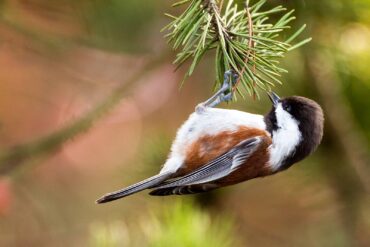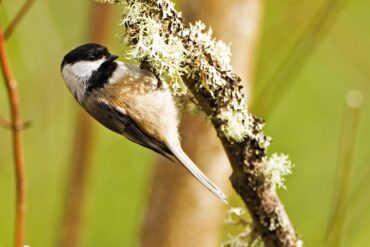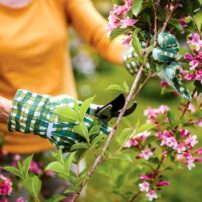
For years, people have debated the appropriateness of feeding wild birds. Some argue that birds rely on feeders instead of looking for natural food sources. Actually, few birds truly depend on backyard feeders. Many species use feeders with appropriate food choices for a quick snack to supplement their natural diet.
Those who feed backyard birds do it primarily for their own pleasure. Bird feeders bring nature in for close viewing. People don’t typically hang feeders where they can’t be readily seen.
Feeder visitors become so familiar that they are sometimes perceived as ordinary and uninteresting. But when each species is closely observed, familiar feathered friends quickly become neighborhood favorites.
Small songbirds at feeders are especially delightful to watch. Their antics and cheerful chatter provide endless entertainment. Among the most charming are the chickadees.
West Sound has two year-round species of chickadees that frequently visit backyards: the black-capped chickadee and the chestnut-backed chickadee.
Black-capped chickadees are the most widespread chickadee and live in virtually any place with trees, with a preference for hardwoods. They are found throughout the northern United States and most of Alaska and Canada.
Chestnut-backed chickadees are more specialized and prefer coniferous forests. They are limited to the coastal and inland forests of the West Coast. Their range stretches from southern Alaska to southwestern California. They’re also found in forests of the Idaho panhandle, western Montana and southeastern British Columbia.

There are two additional chickadee species in Washington. The mountain chickadee resides in the Cascades and in high-elevation forests of the western states and British Columbia. The boreal chickadee inhabits Canada and Alaska. Its range slips into the northern coniferous forests of the United States, including the northeastern corner of Washington.
In all, there are seven species of chickadees, all of which are nonmigratory and reside in North America. The other three are the Carolina chickadee of the Southeast, the Mexican chickadee of western Mexico and the gray-headed chickadee of northern Alaska.
The black-capped chickadee is poorly named, as most chickadee species have heads with black caps, including the chestnut-backed chickadee. Both of West Sound’s chickadees have a white triangular cheek patch, a trademark of the species, which contrasts against a black bib.
The black-capped chickadee is about 5 inches long. Its upperparts and wings are gray, underparts are white and sides and flanks are buffy.
The chestnut-backed chickadee is appropriately named for its chestnut-brown back, rump and flanks. It has a white belly, and the wings and tail are dark brown. The smallest of the species, it measures about 4.5 inches in length.
The black-capped chickadee is known for its easily recognizable “chick-a-dee-dee-dee” call and whistles a slow “fee-bee” song. The chestnut-backed chickadee’s call is a high-pitched and fast “chick-a-dee-dee.” Its song is a less melodic series of “chips.”
Black-capped and chestnut-backed chickadees are very tame and tolerant of a close approach. Both species are curious, social birds and often forage alongside each other. They readily visit feeders with suet, peanuts or sunflower seeds. In fall and winter, these songbirds join flocks of multiple species, including nuthatches, kinglets, vireos, creepers, warblers and woodpeckers.
A chickadee’s natural diet is mostly made up of insects and other arthropods gleaned from tree limbs. Weighing between 9 and 14 grams (about 0.3-0.5 ounces), these featherweight songbirds can cling to any branch and even forage while hanging upside down. Chickadees also eat seeds and berries.
In preparation for winter, chickadees cache seeds under tree bark. They may stash hundreds of seeds a day and are capable of remembering each location for up to 28 days. This is courtesy of a larger hippocampus in the brain than most birds have, which gives them a remarkable memory. Chickadees are careful not to hide anything while potential seed thieves are watching.
Since they are small and agile, chickadees tend to be fearless in the face of predators. They act as sentinels, sending out alarm calls when threats loom. When necessary, they even attack the intruder, particularly when it’s near their nest.
Chickadees are cavity nesters. Black-capped chickadees often excavate a cavity themselves in soft, rotting wood. Chestnut-backed chickadees are weaker excavators and so prefer to use old downy woodpecker holes in trees.
Chickadees sometimes use artificial nest boxes. (For information on nest box size and placement, visit the Cornell Lab of Ornithology’s Nest Watch website at nestwatch.org/learn/all-about-birdhouses.)
Both black-capped and chestnut-backed chickadees are monogamous. Females are responsible for building the nest of moss and soft hair inside the cavity. Brood size is usually six to seven eggs and both parents care for their young.
Black-capped chickadees benefit from increasing forest edges, but chestnut-backed chickadees are more susceptible to decline due to excessive clear-cutting of coniferous forests. Both species prosper when snags are left standing for nesting sites.
Watching birds relieves stress. Chickadees bring charm to our communities, and viewing them is an activity that everyone can enjoy.





























Comments